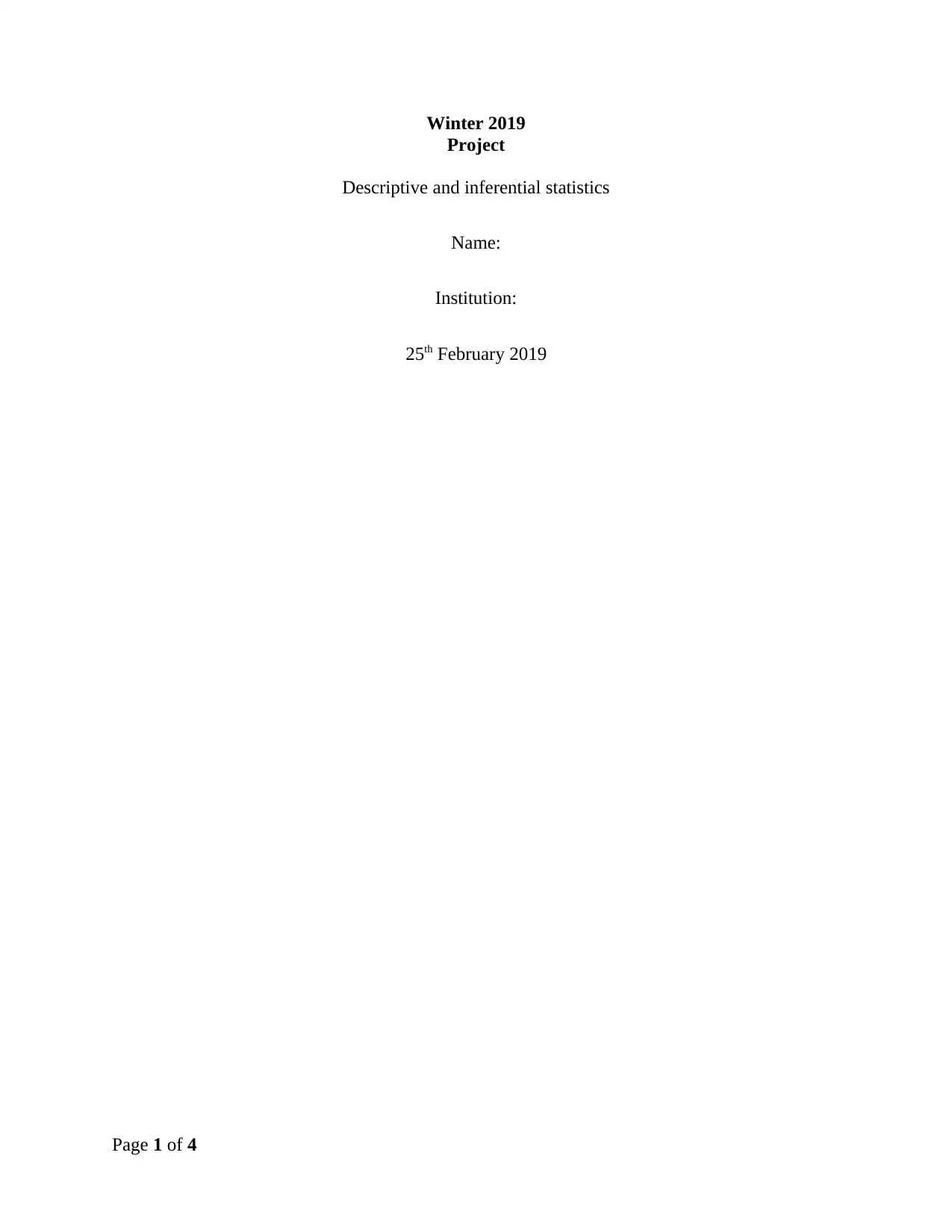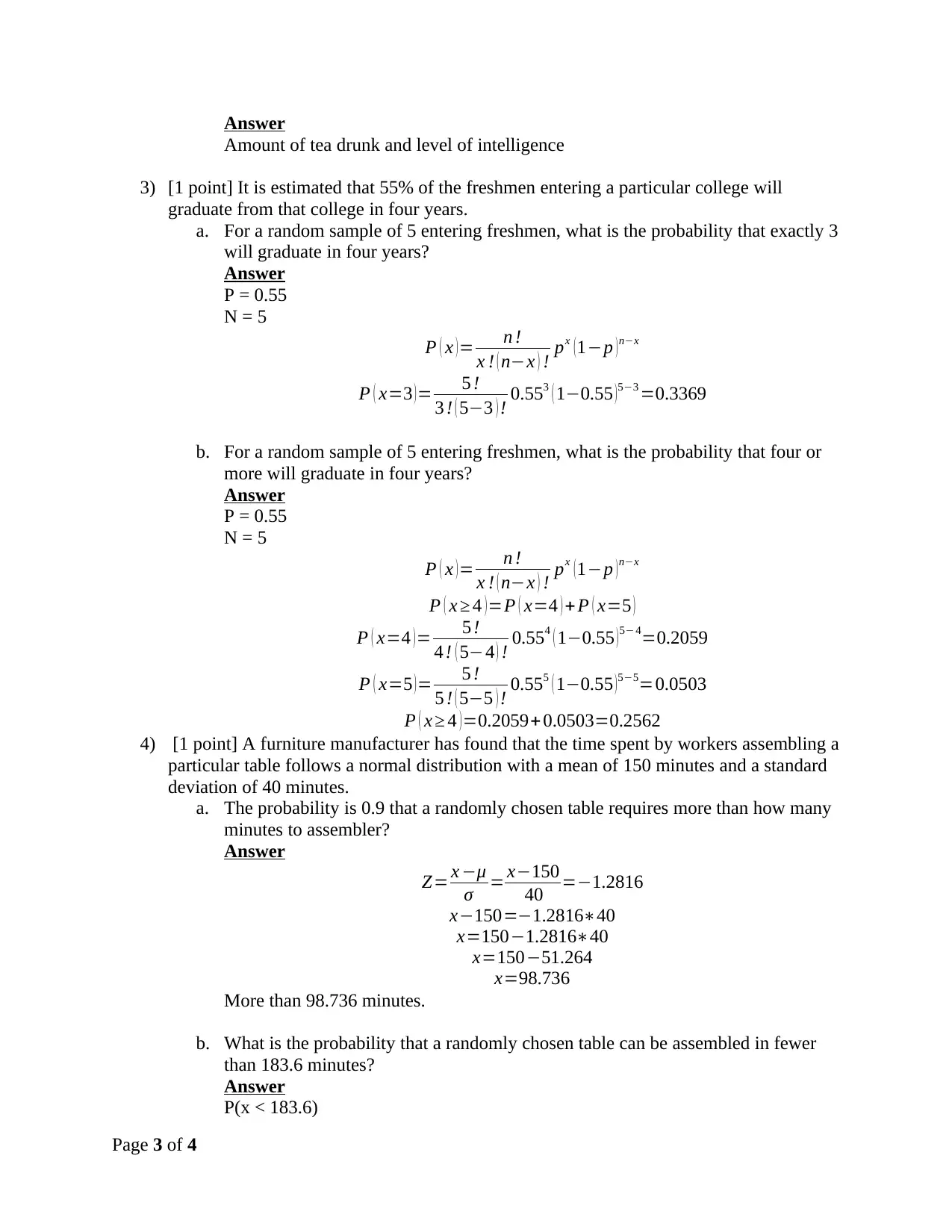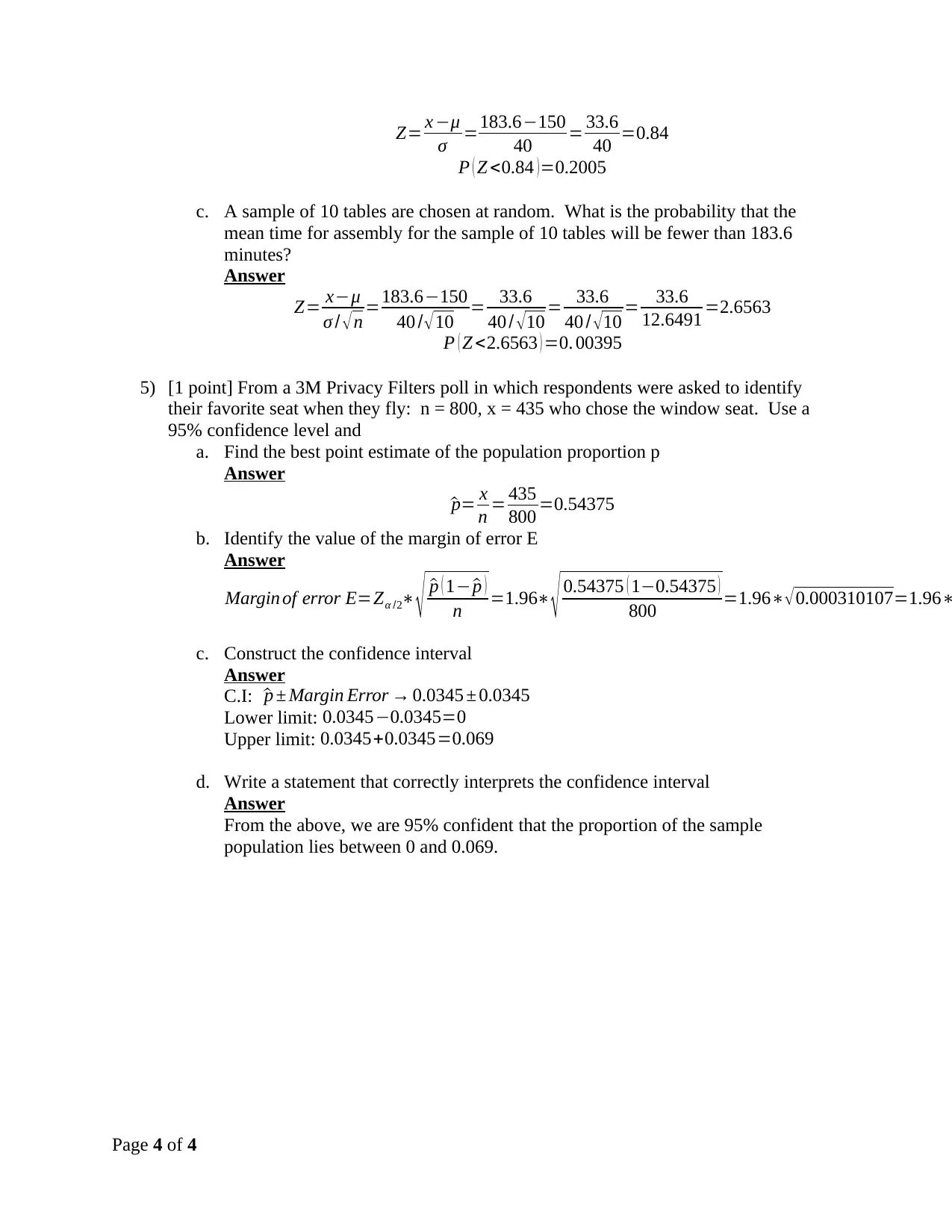Winter 2019 Descriptive and Inferential Statistics Project
VerifiedAdded on 2023/04/23
|4
|972
|238
Homework Assignment
AI Summary
This document presents a complete solution to a statistics project from Winter 2019, focusing on descriptive and inferential statistics. The solution addresses several key concepts, including the binomial distribution, calculating expected values and standard deviations in a multiple-choice test scenario. It also explores covariance with practical examples and probability calculations related to graduation rates. Furthermore, the project delves into the normal distribution, calculating probabilities for assembly times and analyzing confidence intervals for population proportions based on a 3M Privacy Filters poll. The solution provides detailed calculations and interpretations for each problem, offering a comprehensive understanding of the statistical methods used.

Winter 2019
Project
Descriptive and inferential statistics
Name:
Institution:
25th February 2019
Page 1 of 4
Project
Descriptive and inferential statistics
Name:
Institution:
25th February 2019
Page 1 of 4
Paraphrase This Document
Need a fresh take? Get an instant paraphrase of this document with our AI Paraphraser

Please show your work. You may use formulas, tables, or Excel to assist you with the problems.
______________________________________________________________________________
1) [24 points] A multiple-choice test has nine questions. For each question there are four
possible answers from which to select. One point is awarded for each correct answer,
and the points are not subtracted for incorrect answers. The instructor awards a bonus
point if the students spell their name correctly. A student who has not studied for this test
decides to choose an answer for each question at random.
a. Can we use the binomial distribution for this scenario? Why?
Answer
Yes. We can use the binomial distribution for this scenario since there are only
two possible outcomes (getting correct or wrong answer).
b. What is the probability of success for answering any one question correctly?
Answer
P ( success )= x
n = 1
4 =0.25
c. Find the expected number of correct answers for the student on these nine
questions (E = np).
Answer
E ( X ) =np
¿ 9∗0.25=2.25
d. Find the standard deviation of the number of correct answers for the student on
these nine questions.
Answer
SD ( X )= √np(1− p)= √9∗0.25(1−0.25)= √9∗0.25∗0.75= √1.6875=1.299
e. The student spells his name correctly:
i. Find the expected total score on the test for this student.
Answer
Y = X +1
E ( Y ) =E ( X ) +1=2.25+1=3.25
ii. Find the standard deviation of his total score on the test.
Answer
SD ( Y )=SD ( X )=1.299
2) [1 point] Develop realistic examples of pairs of random variables for which you would
expect to find the following:
a. Positive covariance (for example, amount of time studying and score on test
should have a positive covariance; what is another example?)
Answer
Consumer spending and gross domestic product (GDP)
b. Negative covariance
Answer
Oil prices and airline stocks
c. Zero covariance
Page 2 of 4
______________________________________________________________________________
1) [24 points] A multiple-choice test has nine questions. For each question there are four
possible answers from which to select. One point is awarded for each correct answer,
and the points are not subtracted for incorrect answers. The instructor awards a bonus
point if the students spell their name correctly. A student who has not studied for this test
decides to choose an answer for each question at random.
a. Can we use the binomial distribution for this scenario? Why?
Answer
Yes. We can use the binomial distribution for this scenario since there are only
two possible outcomes (getting correct or wrong answer).
b. What is the probability of success for answering any one question correctly?
Answer
P ( success )= x
n = 1
4 =0.25
c. Find the expected number of correct answers for the student on these nine
questions (E = np).
Answer
E ( X ) =np
¿ 9∗0.25=2.25
d. Find the standard deviation of the number of correct answers for the student on
these nine questions.
Answer
SD ( X )= √np(1− p)= √9∗0.25(1−0.25)= √9∗0.25∗0.75= √1.6875=1.299
e. The student spells his name correctly:
i. Find the expected total score on the test for this student.
Answer
Y = X +1
E ( Y ) =E ( X ) +1=2.25+1=3.25
ii. Find the standard deviation of his total score on the test.
Answer
SD ( Y )=SD ( X )=1.299
2) [1 point] Develop realistic examples of pairs of random variables for which you would
expect to find the following:
a. Positive covariance (for example, amount of time studying and score on test
should have a positive covariance; what is another example?)
Answer
Consumer spending and gross domestic product (GDP)
b. Negative covariance
Answer
Oil prices and airline stocks
c. Zero covariance
Page 2 of 4

Answer
Amount of tea drunk and level of intelligence
3) [1 point] It is estimated that 55% of the freshmen entering a particular college will
graduate from that college in four years.
a. For a random sample of 5 entering freshmen, what is the probability that exactly 3
will graduate in four years?
Answer
P = 0.55
N = 5
P ( x ) = n !
x ! ( n−x ) ! px ( 1−p ) n−x
P ( x=3 )= 5 !
3 ! ( 5−3 ) ! 0.553 ( 1−0.55 )5−3 =0.3369
b. For a random sample of 5 entering freshmen, what is the probability that four or
more will graduate in four years?
Answer
P = 0.55
N = 5
P ( x ) = n !
x ! ( n−x ) ! px ( 1−p ) n−x
P ( x ≥ 4 ) =P ( x=4 ) + P ( x=5 )
P ( x=4 )= 5 !
4 ! ( 5−4 ) ! 0.554 ( 1−0.55 )5− 4=0.2059
P ( x=5 ) = 5 !
5 ! ( 5−5 ) ! 0.555 ( 1−0.55 ) 5−5=0.0503
P ( x ≥ 4 ) =0.2059+ 0.0503=0.2562
4) [1 point] A furniture manufacturer has found that the time spent by workers assembling a
particular table follows a normal distribution with a mean of 150 minutes and a standard
deviation of 40 minutes.
a. The probability is 0.9 that a randomly chosen table requires more than how many
minutes to assembler?
Answer
Z= x −μ
σ = x−150
40 =−1.2816
x−150=−1.2816∗40
x=150−1.2816∗40
x=150−51.264
x=98.736
More than 98.736 minutes.
b. What is the probability that a randomly chosen table can be assembled in fewer
than 183.6 minutes?
Answer
P(x < 183.6)
Page 3 of 4
Amount of tea drunk and level of intelligence
3) [1 point] It is estimated that 55% of the freshmen entering a particular college will
graduate from that college in four years.
a. For a random sample of 5 entering freshmen, what is the probability that exactly 3
will graduate in four years?
Answer
P = 0.55
N = 5
P ( x ) = n !
x ! ( n−x ) ! px ( 1−p ) n−x
P ( x=3 )= 5 !
3 ! ( 5−3 ) ! 0.553 ( 1−0.55 )5−3 =0.3369
b. For a random sample of 5 entering freshmen, what is the probability that four or
more will graduate in four years?
Answer
P = 0.55
N = 5
P ( x ) = n !
x ! ( n−x ) ! px ( 1−p ) n−x
P ( x ≥ 4 ) =P ( x=4 ) + P ( x=5 )
P ( x=4 )= 5 !
4 ! ( 5−4 ) ! 0.554 ( 1−0.55 )5− 4=0.2059
P ( x=5 ) = 5 !
5 ! ( 5−5 ) ! 0.555 ( 1−0.55 ) 5−5=0.0503
P ( x ≥ 4 ) =0.2059+ 0.0503=0.2562
4) [1 point] A furniture manufacturer has found that the time spent by workers assembling a
particular table follows a normal distribution with a mean of 150 minutes and a standard
deviation of 40 minutes.
a. The probability is 0.9 that a randomly chosen table requires more than how many
minutes to assembler?
Answer
Z= x −μ
σ = x−150
40 =−1.2816
x−150=−1.2816∗40
x=150−1.2816∗40
x=150−51.264
x=98.736
More than 98.736 minutes.
b. What is the probability that a randomly chosen table can be assembled in fewer
than 183.6 minutes?
Answer
P(x < 183.6)
Page 3 of 4
⊘ This is a preview!⊘
Do you want full access?
Subscribe today to unlock all pages.

Trusted by 1+ million students worldwide

Z= x −μ
σ =183.6−150
40 = 33.6
40 =0.84
P ( Z <0.84 )=0.2005
c. A sample of 10 tables are chosen at random. What is the probability that the
mean time for assembly for the sample of 10 tables will be fewer than 183.6
minutes?
Answer
Z= x−μ
σ / √n =183.6−150
40 / √10 = 33.6
40 / √10 = 33.6
40 / √10 = 33.6
12.6491 =2.6563
P ( Z <2.6563 ) =0. 00395
5) [1 point] From a 3M Privacy Filters poll in which respondents were asked to identify
their favorite seat when they fly: n = 800, x = 435 who chose the window seat. Use a
95% confidence level and
a. Find the best point estimate of the population proportion p
Answer
^p= x
n = 435
800 =0.54375
b. Identify the value of the margin of error E
Answer
Margin of error E=Zα /2∗ √ ^p ( 1− ^p )
n =1.96∗ √ 0.54375 ( 1−0.54375 )
800 =1.96∗√0.000310107=1.96∗
c. Construct the confidence interval
Answer
C.I: ^p ± Margin Error → 0.0345 ± 0.0345
Lower limit: 0.0345−0.0345=0
Upper limit: 0.0345+0.0345=0.069
d. Write a statement that correctly interprets the confidence interval
Answer
From the above, we are 95% confident that the proportion of the sample
population lies between 0 and 0.069.
Page 4 of 4
σ =183.6−150
40 = 33.6
40 =0.84
P ( Z <0.84 )=0.2005
c. A sample of 10 tables are chosen at random. What is the probability that the
mean time for assembly for the sample of 10 tables will be fewer than 183.6
minutes?
Answer
Z= x−μ
σ / √n =183.6−150
40 / √10 = 33.6
40 / √10 = 33.6
40 / √10 = 33.6
12.6491 =2.6563
P ( Z <2.6563 ) =0. 00395
5) [1 point] From a 3M Privacy Filters poll in which respondents were asked to identify
their favorite seat when they fly: n = 800, x = 435 who chose the window seat. Use a
95% confidence level and
a. Find the best point estimate of the population proportion p
Answer
^p= x
n = 435
800 =0.54375
b. Identify the value of the margin of error E
Answer
Margin of error E=Zα /2∗ √ ^p ( 1− ^p )
n =1.96∗ √ 0.54375 ( 1−0.54375 )
800 =1.96∗√0.000310107=1.96∗
c. Construct the confidence interval
Answer
C.I: ^p ± Margin Error → 0.0345 ± 0.0345
Lower limit: 0.0345−0.0345=0
Upper limit: 0.0345+0.0345=0.069
d. Write a statement that correctly interprets the confidence interval
Answer
From the above, we are 95% confident that the proportion of the sample
population lies between 0 and 0.069.
Page 4 of 4
1 out of 4
Related Documents
Your All-in-One AI-Powered Toolkit for Academic Success.
+13062052269
info@desklib.com
Available 24*7 on WhatsApp / Email
![[object Object]](/_next/static/media/star-bottom.7253800d.svg)
Unlock your academic potential
Copyright © 2020–2025 A2Z Services. All Rights Reserved. Developed and managed by ZUCOL.



